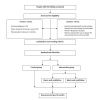Impact of Dance or Music and Meditation on the Progression of Parkinson Disease With Mild or Moderate Severity: Protocol for a Pilot Randomized Controlled Trial
- PMID: 39471378
- PMCID: PMC11558214
- DOI: 10.2196/59018
Impact of Dance or Music and Meditation on the Progression of Parkinson Disease With Mild or Moderate Severity: Protocol for a Pilot Randomized Controlled Trial
Abstract
Background: Parkinson disease (PD) is a progressive neurodegenerative disorder characterized by motor dysfunctions and nonmotor symptoms. Current treatments do not alter disease progression, highlighting the need for alternative therapies. Music, dance, and mindfulness meditation have shown the potential to improve symptoms and quality of life in patients with PD.
Objective: This study aims to evaluate the effectiveness of dance or music and meditation on PD progression, cognitive functions, mood, behavior, and caregiver burden.
Methods: This study is a single-blinded, longitudinal, parallel, randomized controlled trial. The participants consist of 30 patients with mild to moderate PD residing in Mumbai, India, who can physically participate in the activities. The exclusion criteria include advanced PD, severe balance issues, age >80 years, and other movement disorders. Participants in the intervention group will engage in dance or music sessions and guided meditation thrice weekly for 6 months. The control group will continue their usual activities and medication. The primary outcome is the progression of PD symptoms, measured using the Unified Parkinson's Disease Rating Scale I-III, and quality of life, measured using the Parkinson's Disease Questionnaire-39. The secondary outcomes include cognitive functions (Mini-Mental State Examination), mood (Beck Depression Inventory and Parkinson Anxiety Scale), mobility (timed up and go and Berg Balance Test), behavioral disorders (Questionnaire for Impulsive-Compulsive Disorders in Parkinson's Disease Rating Scale), and caregiver burden (Zarit Burden Interview and Parkinson's Disease Questionnaire-Carer).
Results: Data collection was completed in February 2024, with 28 participants finishing the study (intervention group: n=15, 54% and control group: n=13, 46%). Data analysis is underway, with results expected to be published in December 2024.
Conclusions: This study aims to provide significant insights into the effectiveness of dance or music and meditation in improving the quality of life and slowing the progression of PD. The findings are anticipated to support using these nonpharmaceutical therapies as complementary approaches to managing PD.
Trial registration: CTRI/2023/03/051064; https://tinyurl.com/2xdus53j.
International registered report identifier (irrid): DERR1-10.2196/59018.
Keywords: Parkinson disease; dance therapy; meditation; music; music therapy; neurodegenerative disorders; pilot study; quality of life; well-being.
©Bhagyashree Mehrotra, Neha Rai, Rajani MR, Aparna Budhakar, Ritika Aggarwal, Raj Vinodkumar Agarbattiwala, Mona Thomas, Sampada Patole, Paresh Doshi. Originally published in JMIR Research Protocols (https://www.researchprotocols.org), 29.10.2024.
Conflict of interest statement
Conflicts of Interest: None declared.
Figures
References
-
- Muangpaisan W, Hori H, Brayne C. Systematic review of the prevalence and incidence of Parkinson's disease in Asia. J Epidemiol. 2009;19(6):281–293. doi: 10.2188/jea.je20081034. http://joi.jlc.jst.go.jp/JST.JSTAGE/jea/JE20081034?from=PubMed JST.JSTAGE/jea/JE20081034 - DOI - PMC - PubMed
-
- Verma AK, Raj J, Sharma V, Singh TB, Srivastava S, Srivastava R. Epidemiology and associated risk factors of Parkinson's disease among the north Indian population. Clin Epidemiol Glob Health. 2017;5(1):8–13. doi: 10.1016/j.cegh.2016.07.003. - DOI
-
- di Biase L, Summa S, Tosi J, Taffoni F, Marano M, Cascio Rizzo A, Vecchio F, Formica D, Di Lazzaro V, Di Pino G, Tombini M. Quantitative analysis of bradykinesia and rigidity in Parkinson's disease. Front Neurol. 2018;9:121. doi: 10.3389/fneur.2018.00121. https://europepmc.org/abstract/MED/29568281 - DOI - PMC - PubMed
Publication types
MeSH terms
LinkOut - more resources
Full Text Sources
Medical
Miscellaneous


